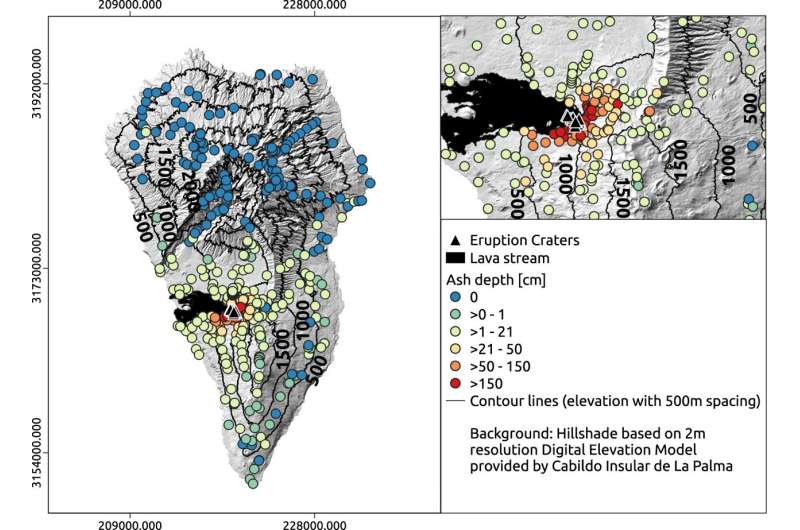This article has been reviewed according to Science X's editorial process and policies. Editors have highlighted the following attributes while ensuring the content's credibility:
fact-checked
trusted source
proofread
Volcanism—an underestimated driver of evolution on oceanic islands

Woody plants are unusually common on oceanic islands. Scientists at the University of Bayreuth, together with research partners in Italy, Great Britain, Norway and Spain, have now discovered a new explanation for this phenomenon: With the lignification of biomass, many plant species native to oceanic islands have protected themselves from the impact of frequent volcanic eruptions, during which large areas are covered with huge amounts of ash.
Woody plants can survive even in ash layers of up to half a meter. Using the example of the Canary Island of La Palma, the European team presents its explanatory approach in the journal npj Biodiversity.
The large number of woody plants on oceanic islands is particularly surprising when compared with biologically related species on the mainland. Many of the insular, highly woody species belong to families and genera represented by herbaceous plant species on the mainland. Charles Darwin sought to explain the conspicuous woodiness on the islands by a competition among plant species for sunlight.
Studies from recent years, on the other hand, have pointed to drought, to which the plants would have adapted by becoming more woody. The new consideration that there could be an evolutionary connection with volcanism, which is frequent on the islands, was triggered by the impact of the heavy volcanic eruptions that occurred on La Palma during several months in 2021. In the course of Earth's history, such eruptions have been repeated many thousands of times on oceanic islands.
"The eruptions of the Tajogaite volcano on La Palma provided a unique opportunity for biogeographical studies. For many years, geological and climatic changes on the Canary Islands have been recorded with scientific precision, so that new observations regarding insular vegetation can be easily integrated into larger explanatory contexts," says Prof. Dr. Carl Beierkuhnlein, the first author of the new study, who is chair of biogeography at the University of Bayreuth.
In April 2022, four months after the end of the volcanic eruptions, he and a Bayreuth research team examined the vegetation on La Palma. Almost the entire surface of the island was covered by a layer of pyroclastic ash that had been ejected from the crater. In total, more than 20 million cubic meters of ash were deposited on the island. In the vicinity of the craters, the ash layer was more than 20 centimeters high over large areas, and more than two meters high in the immediate vicinity.
Surprisingly, most woody plants had survived this event. Even in regions where a layer of ash between ten centimeters and half a meter high had been deposited, they were already in full bloom after a few weeks. In contrast, numerous herbs and grasses remained buried under the ash. Almost all the woody plants that managed to survive are endemic. They only grow on La Palma. Taken together, the findings form an example of biological selection: woodiness proves to be a characteristic that ensures survival and further development on oceanic islands.
Oceanic islands, which have been frequently affected by volcanic eruptions in the course of Earth's history and some of which still are today, have a particularly high proportion of endemic species in their vegetation. In view of the current observations on La Palma, the authors of the new study consider it very likely that the selection of woodiness promoted a survival strategy which enabled plants on volcanic islands to protect themselves from the impact of ash deposits.
Populations of herbaceous plant species that originally had no stabilizing structures developed into endemic woody plants over many generations as the proportion of wood in their biomass increased.
"With our new study, we do not want to deny that other factors such as climatic conditions could have favored and increased the growth of woody plants on oceanic islands. However, our latest observations and measurements on La Palma support the assumption that volcanism is a previously underestimated driver of evolution on oceanic islands. The biogeographical and ecological consequences of volcanic eruptions should therefore be studied more precisely and regularly in the future," says Beierkuhnlein.
More information: Carl Beierkuhnlein et al, Volcanic ash deposition as a selection mechanism towards woodiness, npj Biodiversity (2023). DOI: 10.1038/s44185-023-00018-2
Provided by Bayreuth University




















